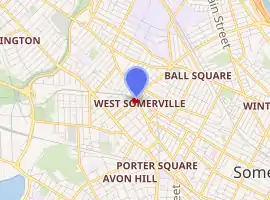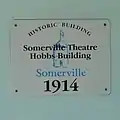Somerville Theatre
The Somerville Theatre is an independent movie theater and concert venue in the Davis Square neighborhood of Somerville, Massachusetts, United States. Over one hundred years old, the Somerville Theatre started off as a vaudeville house and movie theater. The theater has since transitioned and now operates as a live music venue and first-run movie theater. As a music venue, the theater has played host to many historic concerts, including the first of the two Last Dispatch concerts, two shows by Bruce Springsteen in 2003, and a performance by U2 in 2009. Recent live performances have included Ryan Adams & the Cardinals, Cursive, Norah Jones, The Jonas Brothers, Joan Baez, and the John Butler Trio.
 | |

| |
| Address | 55 Davis Square Somerville, Massachusetts United States |
|---|---|
| Owner | FEI Theatres / Frame One Theatres |
| Capacity | 900 / 92 / 31 / 150 / 145 / 92 |
| Current use | cinema, and live music, comedy and dance venue |
| Construction | |
| Opened | 1914 |
| Architect | Funk & Wilcox |
| Website | |
| somervilletheatre | |
Somerville Theater/Hobbs Building | |
  | |
| Coordinates | 42°23′48.3463″N 71°7′22.3645″W |
| Built | 1914 |
| Architectural style | Art Deco |
| MPS | Somerville MRA |
| NRHP reference No. | 89002330[1] |
| Added to NRHP | 1990 |
The building also hosts the Somerville branch of the Museum of Bad Art.
Early years
The Somerville Theater is part of the Hobbs Building which was built in 1914 by Joseph Hobbs and designed by the firm of Funk & Wilcox of Boston. Designed for stage shows, vaudeville, opera, and motion pictures, the theater was only one of the highlights of the Hobbs Building, which also contained a basement café, basement bowling alley and billiards hall, the theater lobbies and ten storefronts on the ground floor, and the Hobbs Crystal Ballroom, a 700-person dance hall, on the second floor. The second and third floors also contained office space for lease. In 1915, the Somerville Theater Players began their stock company presentation of weekly play performances. Among the notable players who came up at the Somerville were Tallulah Bankhead, Kay Corbett, and Francis X. Bushman. Future film director Busby Berkeley (famous for 42nd Street and other stylized musicals of the 1930s) directed many shows at the Somerville Theatre in the mid-1920s.
The movie era
In 1926, the Hobbs family leased and subsequently sold the theater to Arthur F. Viano, whose family built and owned other area theaters such as the Teele Square Theater, the Broadway Theater in East Somerville, and the Regent Theater in Arlington. The Vianos continued with the stock theater company until the harsh economics of the Depression forced them into a 'movies only' policy in 1932. Throughout the 30s, 40s, 50s and 60s, the Somerville remained a prime neighborhood movie house. In those days, new films would open at the downtown theaters like the RKO Keiths (now the Boston Opera House), the Paramount, the Metropolitan (now the Citi Performing Arts Center) and the Loew's Orpheum (now a concert hall). After playing downtown, the pictures made their way, week by week, often two and three per week, to the neighborhood houses like the Somerville Theatre. Like all Viano Theaters, the Somerville was well known for fresh popcorn, and also for gimmicks like prize nights. These gift nights began in the depression and lasted at the Somerville until the 1970s. These were certain nights, usually weekdays, where dishware, appliances, and other merchandise was given away to entice patrons to attend the show. Gradually the Viano family came to operate the Capitol Theater in Arlington as well, and by the 1970s, the Somerville, Capitol, Regent, and Broadway theaters were mainstays of local movie-going. The opening of the Sacks Assembly Square Cinema (now closed) helped to kill the Broadway Theater, and the Fresh Pond Drive-In became a multiplex, forcing the Cambridge-Somerville-Arlington neighborhood theaters to become strictly second-run venues.
Repertory house
The Viano family leased the Somerville to Garen Daly in 1982, and he turned the theater into a repertory house, running double features and daily changes, offering independent and offbeat fare in the days before video and DVD made it easy to track down such titles. Daly also brought back live performances to the stage for the first time since the 1930s when he began programming concerts to complement the film programs. During this period, the Hobbs Building was purchased by Chatham Light Realty, whose owners, the Fraiman family, had previously bought and operated the Capitol Theater in Arlington. When Garen Daly's lease ended in 1989, the Fraimans decided to operate the Somerville themselves, closing the venue for a series of renovations. Some in the community were afraid the original theater would be subdivided into smaller cinemas, and formed an activist group to prevent such an occurrence, but as the owners had never actually made that decision, the theater was preserved, and reopened in 1990.
Renovation and restoration
Movie attendance, however, had dropped considerably, and a plan had to be devised to keep the theater competitive. The remainder of the Hobbs Building, with the exception of a few storefronts and the theater, had been abandoned since the early 80s, and this space proved to be the answer.
In 1996, extensive renovations began. The bowling alleys in the basement and a portion of the first floor retail space were gutted to create modern bathrooms and two new film rooms. Two more screens were built in the former ballroom space on the second floor. An elevator was installed, new windows and a marquee reminiscent of the original were added, and the third and second floors became new modern office space. The theater lobby was expanded by taking over an adjacent storefront, and new comfortable seats were installed in the orchestra seating of the original auditorium.
In 2006, further renovations restored the original auditorium interior to a more historically accurate theme and color scheme while upgrades to the stage like new curtains, rigging, and movie screen were also completed.
In 2008, the second gallery of the Museum of Bad Art opened in the basement of the theater. The gallery was placed near both the women's and men's restrooms, similar to the museum's first gallery location in the Dedham Community Theater.[2] Although the original gallery is free and open to the public, the gallery here is only free with admission to the theater.[3]
In 2009, renovations included new balcony seating, replacing the original seats from 1914; the installation of Dolby Digital Sound and 24 surround speakers throughout the original auditorium; and a revamped projection booth, containing two Norelco DP-70 projectors. The Somerville is now one of the few theaters in New England that can run 70mm film.
Today
The Fraiman family, (then operating as Fraiman Enterprises Inc. - now Frame One Theatres[4]), took ownership of the Somerville Theatre in 1990 and has since made multiple changes to keep up with the evolving movie theater industry.[5][6] Since 1990, 4 screens have been added and digital projectors have been installed. Home to one of the most technically advanced projection booths on the east coast, the Somerville can present virtually any film format - from digital releases to archival 35mm and 70mm film prints.[7] The Somerville also counts a rentable 31-seat "microcinema" among its screening rooms.[8]
The theatre currently operates as a first- and second-run moviehouse, with an emphasis on independent and art house fare. It also regularly hosts live music, dance and comedy performances, with entertainers including U2, Louis CK, Jonathan Richman, Thomas Dolby, and Arlo Guthrie on its stage.
The theatre regularly runs vintage 35mm and 70mm films, silent films with live musical accompaniment,[9] and as of 2016, hosts a yearly "The 70mm and Widescreen Film Festival" in September.[10] It is also the main host theatre for the Independent Film Festival of Boston and The Slutcracker.
The Somerville Theatre is in the minority in the movie theater industry for being locally owned and independent but also operating as a for profit company.
Gallery
_(24264638201).jpg.webp) Elm Street at sunrise, theatre visible on the right
Elm Street at sunrise, theatre visible on the right The Hobbs Building, with the theatre entrance at the right
The Hobbs Building, with the theatre entrance at the right The entrance to the Hobbs Building at 55 Davis Square
The entrance to the Hobbs Building at 55 Davis Square The historical marker sign on the face of the Somerville Theatre Hobbs Building
The historical marker sign on the face of the Somerville Theatre Hobbs Building Following the end of a film showing, audience are exiting the theatre
Following the end of a film showing, audience are exiting the theatre The front entrance of the theatre
The front entrance of the theatre
References
- "History « Somerville Theatre". Feitheatres.com. FEI Theatres. Retrieved 2014-03-04.
- "National Register Information System". National Register of Historic Places. National Park Service. April 15, 2008.
- Smykus, Ed (May 5, 2008). "Museum of Bad Art Will Open Second Branch at the Somerville Theater". Wicked Local Somerville. Perinton, New York: GateHouse Media. Archived from the original on September 17, 2012. Retrieved March 2, 2009.
- "General Info". Somerville Theatre. Retrieved on March 3, 2009.
- "Welcome | Frame ONE Theatres". frameonetheatres.com. Retrieved 2017-05-18.
- Matchan, Linda. "Somerville Theatre celebrates its 100th Birthday". Boston Globe. Boston Globe Media Partners LLC. Retrieved 31 March 2015.
- "Business Entity Summary ID Number: 042815834". Corporate Division. Massachusetts Secretary of State. Retrieved 31 March 2015.
- "Welcome | Frame ONE Theatres". frameonetheatres.com. Retrieved 2017-05-18.
- "Microcinema | Somerville Theatre". Somerville Theatre. Retrieved 2017-05-18.
- "Silents Please | Somerville Theatre". Somerville Theatre. Retrieved 2017-05-18.
- "Time to be Great Again: Presenting Somerville Theatre's Inaugural 70mm & Widescreen Festival". Medium. 2016-09-15. Retrieved 2017-05-18.
